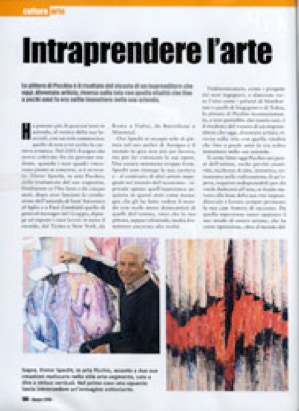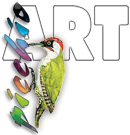Excerpts from Ticino Management of June 2006 about Picchio on the occasion of the exhibition "Art in the Company" at Interroll AG, Sant'Antonino.
by Dr Giorgio Mollisi
He spent about 40 years in his company Interroll with only one regret, namely that he had not become an artist. But in 2001 his dream, which he had already had as a young student, came true when he won a competition with the works he had already exhibited at that time. Dieter Specht, as an artist "Picchio" , a translation of his last name, left the company, left the management of the group to a young CEO and began to paint. - Already exhibited his works all over the world, from Ticino to New York, from Rome to Dubai and from Barcelona to Montreal.
Today Specht dedicates himself only to his painting in his studio in Arcegno and in the world he no longer travels around for the company but to make his works known. - An effort that is no less hard. Specht does not deny his career and - unlike other artists in the business world - he now uses the experience he acquired as a manager. He saw the world with the open eyes of an artist who, although informal, strongly adapted his painting to reality.
Three-dimensional, like the projects of his engineers, or slender in height, like the skyscrapers of Manhattan or Singapore or Tokyo, Picchio's art appears unconsciously and - how could it be otherwise - as the result of the vision of the entrepreneur who, having become an artist, puts his ideas on canvas with the same vitality as he usually did in his company until a few years ago. Today it is well felt that Picchio, as an artist, is able to implement creativity, inventiveness, inventiveness and enthusiasm in the realization of a work of art. These are the basic elements of his life as an entrepreneur that have always brought him success in his "case history". Through these experiences naturally springs his quality as an artist, who incorporates as inspiration not only nature but also that of business.
'The world is vertical everywhere, which is reflected in his paintings, in mountains in plants in houses and skyscrapers, as well as in statistics, rate tables and columns of newspapers`, says Picchio with a naturalness that resembles the child who recognizes reality for the first time. And so I have divided my paintings into verticals.' And so, in fact, explains the reason for painting in segments, divided into vertical stripes, in bright, brilliant colors, pure, clear, applied unmixed with a palette knife, which, in the spirit of divisionism, mix only in the eye of the beholder to form new colors. This Segment-Art, as Picchio calls it, is a precise style that characterizes all his works, whether he only wants to arouse emotions through the power of color without definite form than only through segments, or whether he represents a realistic object, such as a racing car, where the cardial elements of the car are the basis to implement the Segment-Art style. Or take the mountain flowers from Ticino that Picchio discovered during his many walks, where the result, after transformation and division into Segment-Art, ends in an explosion of colors and geometric shapes that evoke an extraordinary emotion.
Picchio achieves the three-dimensional by applying the colors with spatula in relief; but also with his collages, in which he uses the most varied materials with a strong symbolic expressiveness; or with glued strips of linen that stand out from the picture and reinforced with synthetic resin, in torn open and closed forms and games of harmonious colors.
Picchio has also created various representative works that highlight the corporate philosophy of financial institutions and manufacturing companies. He uses clippings from business newspapers, real money, gears and parts of other industrial products that represent the activity of banks, large companies and which Picchio learned as a manager. A very original world of representation of realities, without using conventional forms, but entirely from a creative reprocessing of the artist, who not least wants to trigger emotions of the viewer, and always positive.
Art is cheerfulness, Picchio says with a laugh, because its shapes and its colors actually have the power to awaken cheerfulness in the viewer. For this reason, the artist-company always thought first of the employees of his company when he decorated the different areas with paintings and installations, partly in themes of work and tasks. The employees can better identify with the company through the motifs of the images and are better motivated during work. For example, in the finance department you can find pictures showing motifs of business and finance, with motifs of New York as well as banknotes (before the introduction of the euro in Europe). In the production department you can find large murals with rollers and gears....
And in the entrance hall there is a large representative picture representing the whole philosophy of Interroll, where you can see Ticino in the center of the world and in a spiral the evolution of the company with parts made of polymers from the production of this company that manufactures motors and components for transport systems.
Also Picchio has set up installations made of formats in segments of wood, colorfully painted with putty on all four sides. They can be positioned anywhere in a kind of sculpture straight or diagonally, without any base depending on the space and the sensibility of the owner....
This painting of Picchio is free and without conditions, just as its creator is free, who does not have to follow any fashion to stay in the market, and consequently can realize what he feels and expresses exclusively through his creativity.
Dieter Specht started his multinational career at the age of 64 and in less than 4 years he has already made a breakthrough. In 2002 he already exhibited at the Europ.Art in Geneva and in the same year in Innsbruck, then at the art fair international in Zurich, in de4r Gallery Romang in Gstaad. In 2003 he exhibited at the ArtExpo in New York, he had a solo exhibition at the APC Gallery in Zurich and at the Artgarage Gallery in Zug, again at the Romang Gallery in Gstaad and Ascona, at the Padua Art Fair and the Florence Biennale.
In 2004 he was offered a solo exhibition at the Tondinelli Gallery in Rome, at the Galleria d'Arte in Lisbon and at the Amsterdam Witney Gallery in New York and the Inter.Art Gallery in Salzburg.
From 2005 it is difficult to follow, Picchio's works have been exhibited in Dubai, in Rome, in Ferrara, in Turin, in Padua, in Bari, in Barcelona and Montreal.
This year, 2006, Picchio exhibits at the Caelum Gallery in New York and the D'ArteCon Gallery in Ascona, at the company Interroll AG in Sant'Antonino, as "Corporate Art" (art in the company).
Already in the month of June he will bring his works to Rome, to the Gallery Tondinelli, for the third time as a solo exhibition, and in September to Berlin, where he will exhibit solo with the Gallery Art + Management in the Art Center Berlin.


Studio D’Artecon Sagl
Via E. Pestalozzi 15
CH-6618 Arcegno /Switzerland
Tel: +41 (0)91 791 44 53
E-mail: studio(at)dartecon.net



